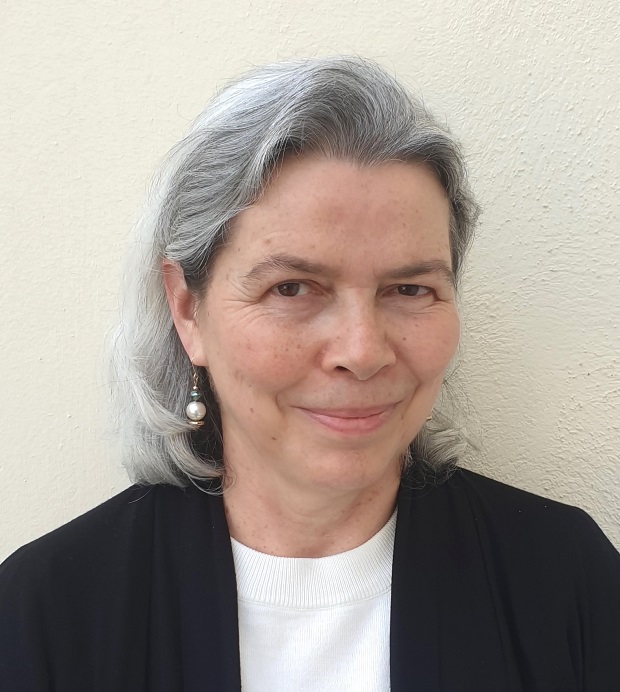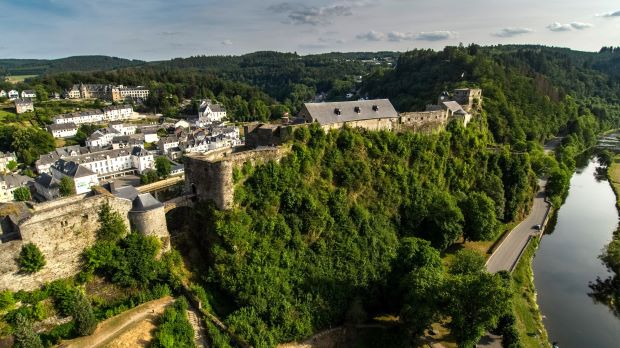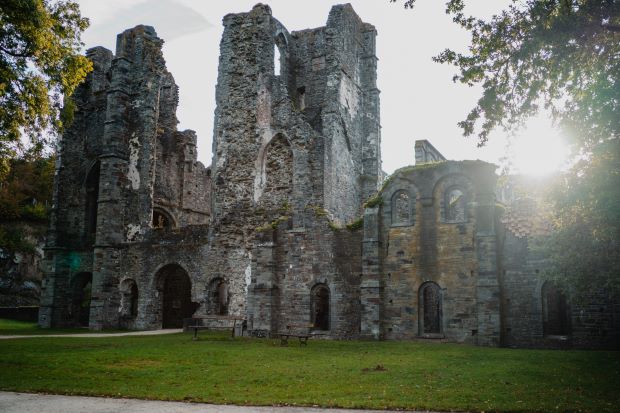- Daily & Weekly newsletters
- Buy & download The Bulletin
- Comment on our articles
Belgium’s medieval history plays a leading role in Brussels author Leona Francombe’s new novel The Heron Legacy
From the legendary crusader Godfrey of Bouillon to tales from the Middle Ages and vestiges of castles across Wallonia, Leona Francombe drew on Belgium’s rich history when crafting her latest novel The Heron Legacy.
This is the writer and musician’s fourth work to be set in her adopted country and has received two awards from The Historical Fiction Company: The Tolstoy European Gold Medal and the 2024 Book of the Year Grand Prize.
The novel follows her previous mystery, The Universe in 3/4 Time, inspired by the rescue of an abandoned piano near her Brussels home, The Sage of Waterloo, written to coincide with the bicentenary of the Battle of Waterloo, and her German-language debut, Madame Ernestine und die Entdeckung der Liebe.
Born in the UK to English and Czech parents, Francombe emigrated to the US at a young age, and has lived in Belgium for over 30 years. She explains to The Bulletin her writing process and how she wove various threads together in The Heron Legacy.

Describe the plot and the characters of this suspense story?
The Heron Legacy is a historical mystery set in the present day. Charles Fontaine, a Belgian relocated to the United States as a youth and now a wealthy New York lawyer, is heir to a large domain in the Ardennes which he returns to Belgium to sell. The property consists of a fading Victorian villa, a ruined medieval castle on a ridge and the lands and forests surrounding them.
Along with being a suspense tale involving a family mystery dating back nine centuries, the novel is also a coming of age story in which Charles, caught between the influences of a beloved uncle and avaricious, controlling father, must find the courage to take charge of his own destiny.
What was the inspiration for this new work?
It came together slowly, over the course of several years, with the various threads only gradually weaving themselves together into a narrative. One ends up with a strange alchemy that blends everything together, very often with unexpected results. Any writer will understand that this process is hardly simple. It can also be frustrating and tiring. However the creative spark, when it’s genuine and heartfelt, is invariably kindled by love: there’s no other way to describe it. Once you feel this passion, no labour is too strenuous in bringing a project to light.

These threads included my enduring fascination with Godfrey of Bouillon and the missing pieces in his story; a visit to the rare manuscripts department of the Royal Library, where Dr Michiel Verweij was kind enough to allow me access to the sole surviving copy of a crusader chronicle, The Deeds of Tancred by Ralph of Caen, ca. 1115; a scramble up a ridge in Luxembourg where my husband and I discovered the vestiges of a castle; a study of pagan women during the militant Christianisation of northern Europe: how they functioned under such duress, and what their talents as healers and seeresses might have been.
As for Charles, his elegance and integrity are a nod to old-fashioned notions of chivalry, minus the sword, of course! Like so many of my main characters, he’s a sort of observer and chronicler of the events that take place around him rather than a hero in the conventional sense.
Which specific Belgian locations can be found in the novel?
Although it is set mostly in Belgium, a long central section takes place in Connecticut and New York. There are also various historic scenes either inspired by the parchment that is central to the story, or drawn directly from crusader chronicles and medieval legends. Brussels is also a strong presence, chiefly the areas around the Sablon and Place Royale, the Forêt de Soignes, and some obscure corners in Uccle and St Gilles.

The accompanying musical trailer is a mix of actual locales (the Semois River; remote ponds in the Ardennes; gloomy groves; the abbey of Villers-la-Ville (pictured) - not located in the Ardennes, of course, but the inspiration for the abbey in the novel) and fictional places that evoke the atmosphere of these real settings. Blancheron Castle, the village of Rêve-sur-Semois and Villa Antioch, all in the Ardennes, are products of the imagination.
How important is this sense of place to your writing?
They are almost characters in themselves, as is the weather. How lucky writers are to live in a country with such brooding moods and ancient, cobbled backwaters. Belgium is a veritable cornucopia of ideas and intrigue… of people with hidden facets and veiled pasts. Often the stage is set simply by soaking up the ambiance of a place. Sometimes a character is so compelling that the minute I spot him or her emerging from a café or rainy park, I simply drop them directly into the story.
What role does history play in all your works?
One of the things that seems to be central in my stories is the depiction of history as a living component of the present. That is, rather than being historical novels in the usual sense, with the entire story set in a certain historical period, they are contemporary narratives in which the past is an intimate player, haunting almost every scene, shadowing the characters’ thoughts and actions and heavily influencing their fate.
My novels also tend to blend historical characters and objects with their fictional counterparts. Conventional historians would probably balk at this mélange of genres, but I believe that with such an approach the lessons of history can still shine through clearly - perhaps even more clearly - than with dry recitations of facts and dates. Though I took liberties with the telling of Godfrey of Bouillon’s story, filling in his shadows with suppositions that were just too tempting to pass up, the biographical details that are generally acknowledged to be true are not lost in the fictional telling of his tale: his castle in Bouillon, his family background, certain personal traits and his controversial role as a crusader.
I would also like readers to notice that the places Godfrey would have known or heard about as a soldier at the end of the 11th century are still, sadly, in the news today, also because of conflict: Tyre, Jerusalem, Aleppo, Baalbek… these and other ancient sites are as restive now as they were when that medieval ruin I stumbled upon in Luxembourg was built. Maybe if writers keep emphasising these tragic and senseless parallels, the lessons of history will finally be heeded.
The Heron Legacy is available for order online in both paperback and eBook formats.
Photos: Bouillon Castle ©WBT/Denis Closon; Villers Abbey WBT/Maxime Collin



















